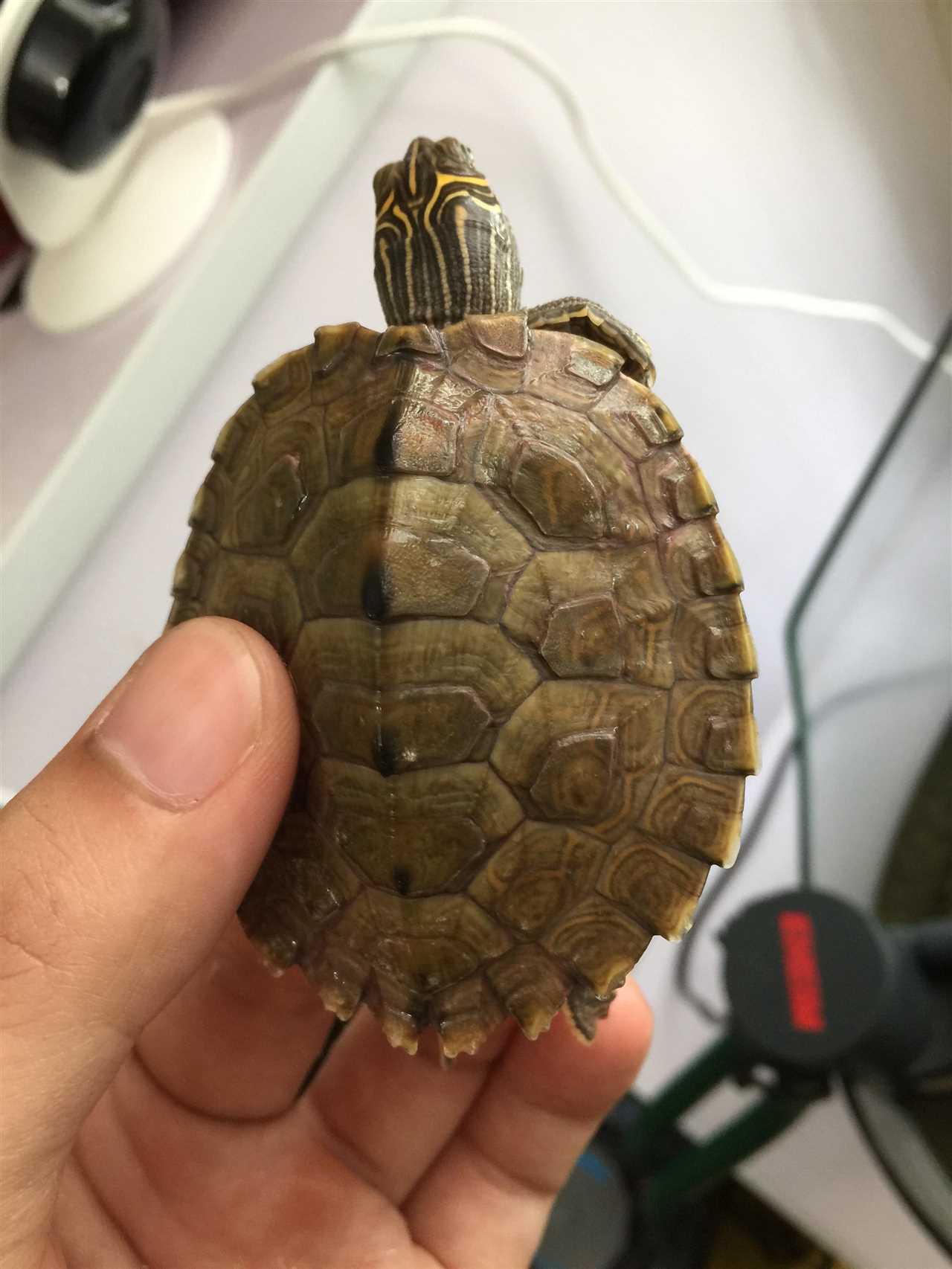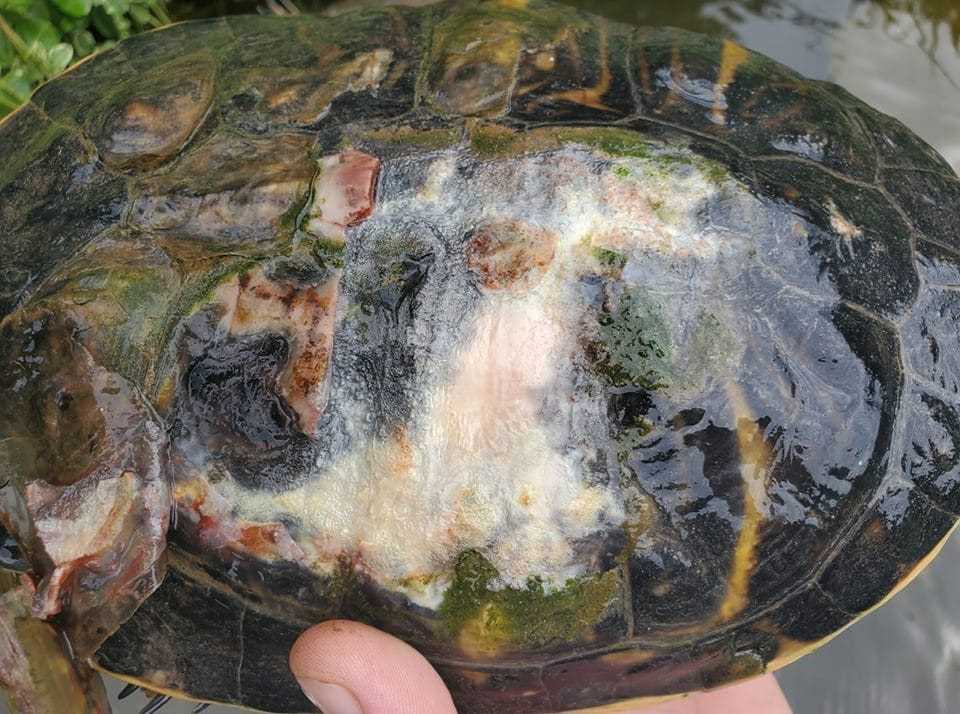
White spots on a turtle’s shell can be caused by a variety of factors. One common cause is a fungal infection. Fungi are microscopic organisms that thrive in moist environments, and turtles are susceptible to fungal infections on their shells. These infections can manifest as white, powdery spots on the shell. Another possible cause of white spots is a condition called “shell rot.” This occurs when bacteria or fungi enter a turtle’s shell and cause it to deteriorate. The result is white or discolored spots on the shell.
Treatment for white spots on a turtle’s shell will depend on the underlying cause. If the spots are caused by a fungal infection, antifungal medications may be prescribed. In some cases, the turtle’s shell may need to be cleaned and treated topically with antifungal creams or ointments. If the whites spots are caused by shell rot, the veterinarian may need to remove the affected portions of the shell and treat the underlying infection.
The Nature of White Spots
White spots on a turtle’s shell can range from small specks to larger patches. They may appear as white or off-white in color, contrasting with the natural pigmentation of the shell. These spots are not to be confused with the regular scutes or markings on the turtle’s shell; they are distinct and abnormal in nature.
Possible Causes
There are several potential causes for the development of white spots on a turtle’s shell. One common cause is a fungal or bacterial infection. If the turtle’s shell is not kept clean and dry, it can create an environment that is conducive to the growth of harmful microorganisms.
In some cases, white spots may also be a sign of a calcium deficiency in the turtle’s diet. This can weaken the shell and make it more susceptible to infections and other issues.
Assessing the Situation
Consult a Veterinarian
If you are unsure about the cause of the white spots or if your turtle is showing any signs of illness, it is best to consult a veterinarian experienced in reptile care. They can perform a thorough examination of your turtle, including taking samples for laboratory testing if necessary.
Based on their assessment, the veterinarian can provide you with a diagnosis and recommend an appropriate treatment plan. This may include topical or oral medications to address bacterial or fungal infections, dietary changes, and improvements to the turtle’s living conditions.
Prevention is Key
Preventing white spots on a turtle’s shell involves maintaining a clean and suitable habitat. Regularly clean and disinfect the tank, provide proper filtration and lighting, and offer a varied and nutritious diet. Additionally, ensure that the water temperature and humidity levels are suitable for your turtle’s species.
Possible Causes of White Spots on Turtle Shell
White spots on a turtle’s shell can be a cause for concern for turtle owners. While these spots may not always be a serious issue, they can sometimes indicate an underlying health problem. There are several possible causes for white spots on a turtle’s shell, including:
1. Fungal Infection: Fungal infections are a common cause of white spots on a turtle’s shell. These infections can occur when the turtle’s environment is not kept clean and the water becomes contaminated. Fungal infections can be treated with antifungal medications prescribed by a veterinarian.
2. Parasites: Parasites such as mites and ticks can cause white spots on a turtle’s shell. These parasites feed on the blood of the turtle and can cause various health issues, including white spots. Treatment for parasites typically involves removing the parasites and providing the turtle with appropriate medication.
3. Shell Rot: Shell rot is a condition where the turtle’s shell becomes damaged or infected. This can lead to the development of white spots. Shell rot is often caused by poor water quality, inadequate diet, or improper husbandry. Treatment for shell rot involves improving the turtle’s living conditions, cleaning the shell, and administering antibiotics if necessary.
5. Trauma: Physical trauma, such as a fracture or injury to the shell, can cause white spots to appear. If a turtle experiences a traumatic injury, it is essential to seek veterinary assistance to assess the extent of the damage and provide appropriate treatment.
Preventing and Treating White Spots on Turtle Shell
Here are some steps to prevent and treat white spots on a turtle’s shell:
| 1. Keep the tank clean | Regularly clean the turtle’s tank to remove any debris or waste that could potentially harbor bacteria or fungi. Use a mild detergent or aquarium-safe cleaner to scrub the tank, making sure to rinse well afterwards. |
| 2. Maintain proper water quality | Monitor the water parameters in the tank, including temperature, pH, and ammonia levels. Use a reliable water testing kit to ensure the water is within the appropriate range for your turtle species. Poor water quality can weaken a turtle’s immune system, making it more susceptible to infections. |
| 3. Provide a balanced diet | Offer a varied and nutritious diet to your turtle. Include a mix of commercial turtle pellets, fresh vegetables, and live or frozen prey (such as insects or small fish). A well-balanced diet helps support a turtle’s overall health and immune system. |
| 4. Avoid overcrowding | Ensure that your turtle has adequate space in the tank. Overcrowding can lead to stress and increased chances of infections. The general rule is to provide 10 gallons of water per inch of turtle shell length. |
| 5. Quarantine new turtles | If you introduce a new turtle to an existing tank, it is essential to quarantine the new turtle first. This helps prevent the transmission of any potential infections to the other turtles in the tank. |
| 6. Regular health checks | Monitor the overall health of your turtle regularly. Look for any changes in behavior, appetite, or the appearance of the shell. If you notice any white spots or other concerning symptoms, consult a veterinarian promptly. |
By following these preventive measures and promptly addressing any white spots on a turtle’s shell, you can help keep your turtle happy and healthy.
Seeking Veterinary Help for White Spots on Turtle Shell
Why Veterinary Help is necessary

White spots on a turtle’s shell can be caused by various factors, such as fungal or bacterial infections, shell rot, or vitamin deficiencies. These conditions can cause discomfort and pain for your turtle and can lead to further health complications if left untreated. It is always best to consult with a professional to accurately diagnose the underlying cause and determine the best course of action.
What to expect during a veterinary visit
During a veterinary visit for white spots on your turtle’s shell, the veterinarian will conduct a thorough examination of your pet. They may ask you questions about your turtle’s diet, habitat, and behavior to gather more information about its overall health. The veterinarian may also request a sample of the white spots or perform additional tests, such as blood work or tissue biopsy, to further investigate the underlying cause.
Based on the findings, the veterinarian will develop a treatment plan tailored to your turtle’s specific needs. This may include topical or oral medications, changes in diet or habitat, or other necessary interventions. They may also provide you with guidance on proper care and prevention strategies to avoid future white spots on the shell.
Preventing white spots on the turtle’s shell
While it is not always possible to prevent white spots on a turtle’s shell, there are steps you can take to minimize the risk. Maintaining a clean and properly balanced habitat, providing a well-rounded and nutritious diet, and ensuring regular veterinary check-ups can help keep your turtle healthy and reduce the likelihood of developing white spots.
Remember, early detection and prompt veterinary intervention are crucial in addressing white spots on your turtle’s shell. By seeking veterinary help, you can ensure the best possible care and improve your turtle’s overall well-being.

I’m Lena Adams—a product of an unconventional upbringing in the African wilderness. My father, a daring explorer of African wildlife, sparked my fascination with reptiles, a passion that intertwined with the tragic loss of my mother during an expedition, leaving an indelible mark on my life. Driven to understand the creatures that captivated my parents, I embarked on my journey, sharing insights about reptiles, frogs, and lizards on my website. Through my explorations and conservation efforts, I honour my family’s legacy while seeking connections—to the creatures, nature, and the mother whose presence I yearn to understand.
